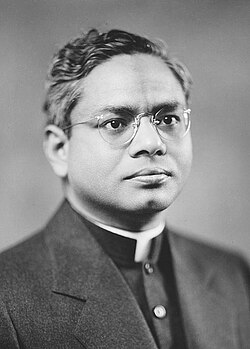Ashokananda
| Ashokananda | |
|---|---|

"A brilliant and accomplished spiritual teacher in the west" – Huston Smith
|
|
| Religion | Hinduism |
| Sect | Non-sectarian. Believes in the truth of all genuine religions. |
| Order | Ramakrishna Order of monks |
| Philosophy | Advaita Vedanta |
| Known for | Spiritual Ministry in America [1932 – 1969], the editor of the Prabuddha Bharata, English monthly organ of the Ramakrishna Order, from 1926 to 1930 |
| Personal | |
| Nationality | Indian |
| Born | Yogeshchandra Dutta [Non-monastic name, till 1923] 23 September 1893 Durgapur, India (Now Bangladesh) |
| Died | 13 December 1969 Vedanta Society of Northern California |
| Guru | Vivekananda [Initiated Ashokananda in a vivid mystical vision, confirmed by four other direct monastic disciples of Ramakrishna--Brahmananda, Premananda, Shivananda and Turiyananda. |
| Disciple(s) | Sister Gargi |
| Literary works | A Heart Poured Out, Shafts of Light, A Disciple's Journal, Ascent to Spiritual Illumination, Meditation Ecstasy and Illumination, A Soul's Journey to its Destiny, A Call to the Eternal, Spiritual Practice, The Influence of the East on the West, Spiritualizing Everyday Life, When the Many become One, Swami Vivekananda in San Francisco, edited Prabuddha Bharata for 5 years, ran The Voice of India magazine in America in 1945–1946, |
| Influenced | Sarvepalli Radhakrishnan, Romain Rolland |
| Dominant preaching | Practical Vedanta |
Meditation is not simply thinking of God. It is an actual perception of God. It is not imagination; it is the anticipation of the Real.
Yogeshchandra Dutta (1893 – December 1969), known as Swami Ashokananda from 1923, was a disciple of Vivekananda of India and a monk of the Ramakrishna Math. From 1932 until his death in December 1969 at the age of 76 he was in charge of the Vedanta Society of Northern California, San Francisco (founded by Vivekananda in 1900).
Dutta was born in the village of Bekitaka. He spent his childhood days in Durgapur, a village seven or eight miles west of the town of Habibganj in the Sylhet district of Assam (now part of Bangladesh).
He joined the Ramakrishna Order in 1921 and was ordained into Sannyasa in 1923 by Swami Shivananda, second President of the Order. He served as an editor of the Prabuddha Bharata, English monthly organ of the Ramakrishna Order, from 1926 to 1930, during which time he refuted some of Mahatma Gandhi's political and economic views.
His story continued in California, starting in the early 1930s, when the Eastern Religions were still looked upon with suspicion in the Western world. Under his leadership the Vedanta Society of Northern California built three temples (in San Francisco, Berkeley and Sacramento) and bought two thousand acres of land in Olema that became the largest Vedanta Retreat in America.
Ashokananda rendered great service to the cause of the Vedanta movement in the West by his clear and thorough expositions of Vedantic teachings through lectures and classes for nearly four decades. A pioneer on the Vedanta frontier, he established new Vedanta Centres in Berkeley and Sacramento, developed the 2000-acre Vedanta Retreat at Olema (still the largest in the western hemisphere), and built the large New Temple in San Francisco to accommodate the Society's growing membership and activities. His contributions to the Vedanta Movement in America are well known, as are his lectures in print, which have become a popular source of inspiration since the first collection was published in 1970.
...
Wikipedia
